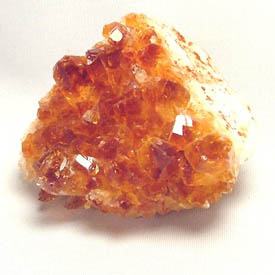|
 Citrine
is a
form of quartz, as is amethyst. It is
characterized by its yellow color, which can range from a pale 'white
wine' to a deep coppery topaz. It is often confused with the rarer and
more expensive topaz, which is harder. Citrine has a hardness of 7,
topaz is 8. Citrine
is a
form of quartz, as is amethyst. It is
characterized by its yellow color, which can range from a pale 'white
wine' to a deep coppery topaz. It is often confused with the rarer and
more expensive topaz, which is harder. Citrine has a hardness of 7,
topaz is 8.
Citrine's color comes from iron impurities
within the crystal. It
typically formed as amethyst, and became citrine due to heating, which
changed the oxidation state of the iron. Some citrine is manufactured
by heat treating amethyst, which occurs more widely in nature - it is
indistinguishable from naturally occurring citrine. Sometimes due to
uneven heating in the earth, amethyst and citrine are found mixed
within the same crystal - this is known as ametrine, and can be quite
beautiful.
Citrine can be faceted for use in jewelry,
or obtained in its raw
form. Citrine geodes are lovely pieces and can be found in a variety of
shades of yellow.
Metaphysically, citrine is associated with
the third chakra, the
solar plexus or 'yellow' chakra, which deals with issues of personal
worth and self-esteem. Use citrine to cleanse yourself of negative
self-images, and unblock your third chakra, freeing yourself to be more
confidence in your own power and decision-making.
Magically, citrine is associated with wealth
and abundance. Use
citrine in workings to boost your personal economy. Sometimes called
'the merchant stone', citrine can be placed in the cash register to
encourage trade. It can also be used for protection.
|